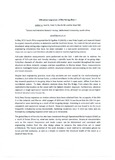- ALSA Home
- →
- Documents
- →
- Research Events
- →
- View Item
JavaScript is disabled for your browser. Some features of this site may not work without it.
| dc.contributor.author | Bekker, A. | |
| dc.contributor.author | Saal, K.l. | |
| dc.contributor.author | Omer, H. | |
| dc.contributor.author | Boulle, B.G. | |
| dc.contributor.author | De Waal, R.J.O. | |
| dc.coverage.spatial | Southern Ocean | |
| dc.coverage.spatial | Antarctica | |
| dc.date.accessioned | 2021-03-10T14:47:01Z | |
| dc.date.available | 2021-03-10T14:47:01Z | |
| dc.date.created | 2016/07/27 | |
| dc.date.issued | 2016/07/27 | |
| dc.identifier.uri | http://hdl.handle.net/123456789/28619 | |
| dc.description.abstract | In May 2012 South Africa acquired the SA Agulhas II (SAA II), a new Polar Supply and research Vessel to support research activities in Antarctica and the Southern Ocean. This state-of-the-art vessel was developed using cutting-edge engineering techniques which are still reliant on model scale tests and engineering simulations that have not been validated in a real-world environment. Actual ship responses are sparse and therefore valuable to advance marine engineering science. Full-scale vibration measurements were performed on the SAA II with the aim to address the sparsity of full-scale data and thereby develop a scientific basis for the design of ice-going ships. Forty-four channels of vibration and structural deformation were recorded throughout the vessel structure on three Antarctic voyages and two expeditions to Marion Island. These measurements serve to investigate human vibration comfort, structural vibration and ice-loading on the shaft line and vessel structure. Despite best engineering practices most ship accidents are not caused by the malfunctioning of machinery, but rather the human factor, a critical contributor to the safety of ship travel. One of the key research questions in ice-going ships is how human comfort in open water, differs from that in ice-infested waters. To date, vibration analyses show that the Bridge, from where the vessel is controlled is the location on the vessel with the highest vibration exposure. Furthermore, vibration exposure in rough open water exceeds that of operations in ice, although ice passage causes higher levels of vibration more frequently. Daily Diary Survey responses on motion sickness have been collected from the occupants of the SAA II on the Antarctic and Marion relief voyages of 2014 and 2015. It was found that the SAA II is pre disposed to wave slamming as a result of her ice-going design. Slamming is correlated with human complaints and equipment damage on board. Sleep and equipment use was found to be the most frequently indicated by survey respondents. Slamming incidences occur in mild sea states and are followed by a whipping response which lasts up to 40 seconds. The global flexure of the ship has also been monitored through Operational Modal Analysis (OMA) as a result of forces (from ice, wind and water) during normal operations. Structural characteristics such as the natural frequencies and mode shapes can be determined and correlated with engineering models from the ship design phase to advance the state-of-the art in vessel architecture. The future potential of this work includes a novel method to estimation global ice forces and hull resistance, as well as a means to monitor the structural health of the vessel as a result of these forces. | en_ZA |
| dc.description.sponsorship | Sponsored by the the Department of Science and Innovation(DSI) through National Research Foundation (NRF) - South Africa | en_ZA |
| dc.description.statementofresponsibility | Antarctic Legacy of South Africa | en_ZA |
| dc.format | en_ZA | |
| dc.language | English | en_ZA |
| dc.publisher | South African National Antarctic Programme (SANAP) | en_ZA |
| dc.relation | SANAP Symposium 2016 | en_ZA |
| dc.rights | Copyright | en_ZA |
| dc.subject | Research | en_ZA |
| dc.subject | Science | en_ZA |
| dc.subject | Meetings | en_ZA |
| dc.subject | Symposium | en_ZA |
| dc.subject | SANAP Symposium 2016 | en_ZA |
| dc.subject | Southern Ocean | en_ZA |
| dc.subject | Antarctica | en_ZA |
| dc.subject | Research | en_ZA |
| dc.subject | Engineering | en_ZA |
| dc.subject | Transport | en_ZA |
| dc.subject | Sea | en_ZA |
| dc.subject | Ships | en_ZA |
| dc.subject | SA Agulhas II | en_ZA |
| dc.subject | Vessels | en_ZA |
| dc.subject | Hulls | en_ZA |
| dc.subject | Vibrations | en_ZA |
| dc.subject | Physical Oceanography | en_ZA |
| dc.title | Vibration responses of the SA Agulhas II | en_ZA |
| dc.type | Presentation-Abstracts | en_ZA |
| dc.rights.holder | Antarctic Legacy of South Africa | en_ZA |
| dc.rights.holder | Bekker, A. | en_ZA |
| dc.rights.holder | Saal, K.l. | en_ZA |
| dc.rights.holder | Omer, H. | en_ZA |
| dc.rights.holder | Boulle, B.G. | en_ZA |
| dc.rights.holder | De Waal, R.J.O. | en_ZA |
| iso19115.mdconstraints.uselimitation | This item and the content of this website are subject to copyright protection. Reproduction of the content, or any part of it, other than for research, academic or non-commercial use is prohibited without prior consent from the copyright holder. | en_ZA |
| iso19115.mddistributor.distributorcontact | South African National Antarctic Programme (SANAP) | en_ZA |
| iso19115.mdformat.name | en_ZA | |
| iso19115.mdidentification.deliverypoint | Antarctic Legacy of South Africa, Faculty of Science, Private Bag X1, Matieland. Stellenbosch. South Africa. | en_ZA |
| iso19115.mdidentification.electronicmailaddress | antarcticlegacy@sun.ac.za | en_ZA |
| iso19115.mdidentification.organizationname | Stellenbosch University | en_ZA |
Files in this item
This item appears in the following Collection(s)
-
Research Events [502]
Material directly related to official scientific and research events

